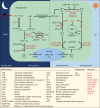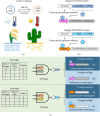Biosystems Design to Accelerate C3-to-CAM Progression
- PMID: 37849902
- PMCID: PMC10521703
- DOI: 10.34133/2020/3686791
Biosystems Design to Accelerate C3-to-CAM Progression
Abstract
Global demand for food and bioenergy production has increased rapidly, while the area of arable land has been declining for decades due to damage caused by erosion, pollution, sea level rise, urban development, soil salinization, and water scarcity driven by global climate change. In order to overcome this conflict, there is an urgent need to adapt conventional agriculture to water-limited and hotter conditions with plant crop systems that display higher water-use efficiency (WUE). Crassulacean acid metabolism (CAM) species have substantially higher WUE than species performing C3 or C4 photosynthesis. CAM plants are derived from C3 photosynthesis ancestors. However, it is extremely unlikely that the C3 or C4 crop plants would evolve rapidly into CAM photosynthesis without human intervention. Currently, there is growing interest in improving WUE through transferring CAM into C3 crops. However, engineering a major metabolic plant pathway, like CAM, is challenging and requires a comprehensive deep understanding of the enzymatic reactions and regulatory networks in both C3 and CAM photosynthesis, as well as overcoming physiometabolic limitations such as diurnal stomatal regulation. Recent advances in CAM evolutionary genomics research, genome editing, and synthetic biology have increased the likelihood of successful acceleration of C3-to-CAM progression. Here, we first summarize the systems biology-level understanding of the molecular processes in the CAM pathway. Then, we review the principles of CAM engineering in an evolutionary context. Lastly, we discuss the technical approaches to accelerate the C3-to-CAM transition in plants using synthetic biology toolboxes.
Copyright © 2020 Guoliang Yuan et al.
Conflict of interest statement
The authors declare that there is no conflict of interest regarding the publication of this article.
Figures





References
-
- Division U. N. P.World Population Prospects: 2019 Revision, United Nations New York, NY, 2019
-
- DeNicola E., Aburizaiza O. S., Siddique A., Siddique A., Khwaja H., and Carpenter D. O., “Climate change and water scarcity: the case of Saudi Arabia,” Annals of Global Health, vol. 81, no. 3, pp. 342–353, 2018 - PubMed
-
- Smith P., and Gregory P. J., “Climate change and sustainable food production,” The Proceedings of the Nutrition Society, vol. 72, no. 1, pp. 21–28, 2013 - PubMed
-
- Karp A., and Richter G. M., “Meeting the challenge of food and energy security,” Journal of Experimental Botany, vol. 62, no. 10, pp. 3263–3271, 2011 - PubMed
Publication types
LinkOut - more resources
Full Text Sources
Miscellaneous

